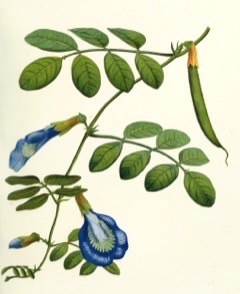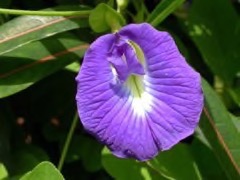 |
|
edibleplants.org |
 |
| Marco Schmidt wikimedia.org |
Translate this page:
Summary
Sometimes misspelt as Clitorea ternata
Physical Characteristics

 Clitoria ternatea is a deciduous Climber growing to 3 m (9ft) by 0.2 m (0ft 8in) at a fast rate.
Clitoria ternatea is a deciduous Climber growing to 3 m (9ft) by 0.2 m (0ft 8in) at a fast rate.
See above for USDA hardiness. It is hardy to UK zone 10. The flowers are pollinated by Insects. The plant is not self-fertile.
It can fix Nitrogen.
Suitable for: light (sandy), medium (loamy) and heavy (clay) soils, prefers well-drained soil and can grow in heavy clay soil. Suitable pH: mildly acid, neutral and basic (mildly alkaline) soils and can grow in very acid and very alkaline soils.
It cannot grow in the shade. It prefers dry or moist soil.
UK Hardiness Map
US Hardiness Map
Synonyms
Clitoria mearnsii De Wild. Clitoria tanganicensis Micheli Clitoria zanzibarensis Vatke.
Plant Habitats
Edible Uses
Edible Parts: Flowers Leaves Seedpod
Edible Uses:
The young pods are eaten as a vegetable[301 , 310 , 418 ]. The flowers are used to give a blue tinge to rice cakes and boiled rice[301 , 418 ]. Young leaves - cooked and used as a vegetable[301 ]. The leaves can also be used to colour food[301 ]. Carbon Farming - Staple Crop: protein.
References More on Edible Uses
Medicinal Uses
Plants For A Future can not take any responsibility for any adverse effects from the use of plants. Always seek advice from a professional before using a plant medicinally.
In traditional Ayurvedic medicine, it is ascribed various qualities including memory enhancing, nootropic, antistress, anxiolytic, antidepressant, anticonvulsant, tranquilizing, and sedative properties.[11] In traditional Chinese medicine, the plant has been ascribed properties affecting female libido due to its similar appearance to the female reproductive organ. The flowers are mixed with water in a preparation used to treat eye problems[348 ]. The powdered, ripe seeds are aperient and purgative[240 , 459 ]. The roots are bitter, powerfully cathartic, diuretic and purgative[240 , 459 ]. The rootbark is diuretic and laxative[240 ]. The plant is used in the treatment of snakebites[240 ]. The seeds contain a fixed oil, a bitter resinous principle and tannins[240 ]. The rootbark contains tannins[240 ].
References More on Medicinal Uses
The Bookshop: Edible Plant Books
Our Latest books on Perennial Plants For Food Forests and Permaculture Gardens in paperback or digital formats.

Edible Tropical Plants
Food Forest Plants for Hotter Conditions: 250+ Plants For Tropical Food Forests & Permaculture Gardens.
More

Edible Temperate Plants
Plants for Your Food Forest: 500 Plants for Temperate Food Forests & Permaculture Gardens.
More

More Books
PFAF have eight books available in paperback and digital formats. Browse the shop for more information.
Shop Now
Other Uses
Fodder
Agroforestry Uses: Butterfly pea has a reputation as a potential fodder plant, hay or cover crop. It has been extensively tested as such, especially in the subhumid to semi-arid tropics. It has never been used in extensive areas, although it is used by smallholders. It is used as a cover crop in coconut in southern India and in rubber in Malaysia[310 ]. A fast-growing plant, it provides good ground cover[418 ]. Other Uses: The leaves and flowers are used as a dye[301 ]. The seeds and bark are a source of tannins[418 ]. Carbon Farming - Agroforestry Services: nitrogen.
Special Uses
Carbon Farming
References More on Other Uses
Cultivation details
Agroforestry Services: Nitrogen Management: Hay Minor Global Crop Staple Crop: Protein
Butterfly pea is essentially a plant of the humid and subhumid tropical lowlands at elevations from sea level to around 1,600 metres[310 ]. It is also grown as an annual in warm temperate areas[310 ]. It grows best in areas with an annual rainfall in the region of 1,500mm, but it has a reputation for drought tolerance in the seasonally dry tropics (with 500 - 900 mm annual rainfall) and can probably survive with as little as 400mm annual rainfall[310 ]. Its annual mean temperature range is 19 - 28°c and it has survived moderate frost damage in the subtropics (at a latitude of 26°S)[310 ]. Plants can succeed on a variety of soils as long as they are well-drained, but prefer a fertile, friable soil, growing poorly on infertile sandy soils if they not fertilized[310 ]. It does well on heavy clay soils[310 ]. Prefers a position in full sun[310 ]. It succeeds within a pH range of 5.5 - 8.9[310 ]. Butterfly pea is one of the few herbaceous legumes well adapted to heavy clay soils in the subhumid to semi-arid tropics and the only one with potential in irrigated pasture mixtures on these soils[310 ]. Early growth of the plant from seed is rapid in warm moist conditions. Growth of established plants is mostly from the apices of the main axis and axillary branches; very few new shoots arise from ground level[310 ]. Growth is more or less continuous in the humid tropics, or with irrigation in other hot regions. Individual plants may live for several years and grow into large vines if undisturbed[310 ]. In the seasonally dry tropics and in cool regions, growth is limited by lack of moisture or low temperatures. Leaves are shed in response to these stresses and top growth may be killed by frost or fire. However, recovery during the following growing season is usually good[310 ] Butterfly pea competes fairly well with weeds once established and can cover the ground in 4 - 6 weeks when sown at a population of 4 plants per square metre. Establishment may be a problem on fertile soils if sown with a vigorous companion grass or oversown into an existing pasture. It combines better with tussock than stoloniferous grasses in mixed pastures. The location of its growing points at the ends of the main branches makes it susceptible to frequent low cutting as well as to continuous heavy grazing[310 ]. Flowers are cleistogamous but a small level of outcrossing occurs. Time to flowering can range from 7 - 11 weeks. Subsequent flowering flushes overlap pod maturation from the previous flush, and they continue throughout the year in frost-free regions. At higher latitudes in the tropics, there is usually a peak at the end of the wet season and again at the end of the cool season, if moisture is available. Pods mature in 8 - 10 weeks after flowering and shatter readily once fully dry. There is considerable variation in the size of flowers and leaflets[310 ]. The plant is propagated by seed and readily self- propagates and spreads under favourable conditions by seed thrown vigorously from the dehiscing dry pods. Seed is also spread in cattle dung[310 ].Inoculation of butterfly pea seed with rhizobia is not usually necessary; but, if it is required, broad spectrum cowpea inoculum should be used[310 ]. This species has a symbiotic relationship with certain soil bacteria, these bacteria form nodules on the roots and fix atmospheric nitrogen. Some of this nitrogen is utilized by the growing plant but some can also be used by other plants growing nearby[200 ]. Climate: tropical. Humidity: semi-arid to humid. Carbon Farming - Cultivation: minor global crop. Management: hay.
Carbon Farming
-
Agroforestry Services: Nitrogen
Plants that contribute to nitrogen fixation include the legume family – Fabaceae.
-
Management: Hay
Cut to the ground and harvested annually. Non-destructive management systems maintaining the soil organic carbon.
-
Minor Global Crop
These crops are already grown or traded around the world, but on a smaller scale than the global perennial staple and industrial crops, The annual value of a minor global crop is under $1 billion US. Examples include shea, carob, Brazil nuts and fibers such as ramie and sisal.
-
Staple Crop: Protein
(16+ percent protein, 0-15 percent oil). Annuals include beans, chickpeas, lentils, cowpeas, and pigeon peas. Perennials include perennial beans, nuts, leaf protein concentrates, and edible milks.
References Carbon Farming Information and Carbon Sequestration Information
Temperature Converter
Type a value in the Celsius field to convert the value to Fahrenheit:
Fahrenheit:
The PFAF Bookshop
Plants For A Future have a number of books available in paperback and digital form. Book titles include Edible Plants, Edible Perennials, Edible Trees,Edible Shrubs, Woodland Gardening, and Temperate Food Forest Plants. Our new book is Food Forest Plants For Hotter Conditions (Tropical and Sub-Tropical).
Shop Now
Plant Propagation
Seed - hand-harvested seed often remains hard-seeded for a long time and requires scarification prior to sowing. Mechanical abrasion, hot water or sulphuric acid can be used to break this dormancy. The seed is normally sown from the beginning until the middle of the wet season at rates of (1-)3 - 5 kg/ha in well-prepared seed-beds with seed placement 1.5 - 4 cm deep and lightly covered[310 ]. Higher rates (5 - 8 kg/ha) may be required when sowing pastures in rough conditions[310 ]. Germination is epigeal; the radicle emerges within 48 - 72 hours and seedlings emerge in 3 - 6 days, depending on planting depth[310 ].
Other Names
If available other names are mentioned here
Asian pigeonwings, bluebellvine, blue pea, butterfly pea, cordofan pea and Darwin pea,
Native Range
Coming Soon
Weed Potential
Right plant wrong place. We are currently updating this section.
Please note that a plant may be invasive in one area but may not in your area so it's worth checking.
None Known
Conservation Status
IUCN Red List of Threatened Plants Status : This taxon has not yet been assessed

Growth: S = slow M = medium F = fast. Soil: L = light (sandy) M = medium H = heavy (clay). pH: A = acid N = neutral B = basic (alkaline). Shade: F = full shade S = semi-shade N = no shade. Moisture: D = dry M = Moist We = wet Wa = water.
Now available:
Food Forest Plants for Mediterranean Conditions
350+ Perennial Plants For Mediterranean and Drier Food Forests and Permaculture Gardens.
[Paperback and eBook]
This is the third in Plants For A Future's series of plant guides for food forests tailored to
specific climate zones. Following volumes on temperate and tropical ecosystems, this book focuses
on species suited to Mediterranean conditions—regions with hot, dry summers and cool, wet winters,
often facing the added challenge of climate change.
Read More
Expert comment
Author
L.
Botanical References
Links / References
For a list of references used on this page please go here
A special thanks to Ken Fern for some of the information used on this page.
Readers comment
| Add a comment |
|
If you have important information about this plant that may help other users please add a comment or link below. Only comments or links that are felt to be directly relevant to a plant will be included. If you think a comment/link or information contained on this page is inaccurate or misleading we would welcome your feedback at [email protected]. If you have questions about a plant please use the Forum on this website as we do not have the resources to answer questions ourselves.
* Please note: the comments by website users are not necessarily those held by PFAF and may give misleading or inaccurate information.
To leave a comment please Register or login here All comments need to be approved so will not appear immediately.
|
Subject : Clitoria ternatea
|
|
|
|